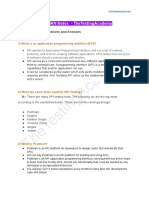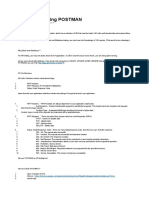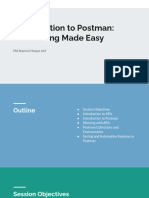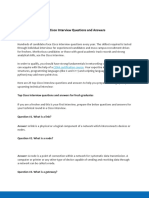Postman_API_Testing_Interview_Questions
Uploaded by
Saim IqbalPostman_API_Testing_Interview_Questions
Uploaded by
Saim IqbalAPI Testing with Postman: Interview Questions and Answers
1. Postman Basics
Q: What is Postman, and why is it used for API testing?
A: Postman is a popular API testing tool that allows users to design, test, and document APIs
efficiently. It is used to validate API functionality, performance, and security.
Q: How do you create and send a request in Postman?
A: To create and send a request in Postman:
1. Open Postman and click 'New' > 'Request'.
2. Enter the request name and save it in a collection.
3. Select the HTTP method (GET, POST, etc.).
4. Enter the API URL.
5. Configure headers, params, or body as needed.
6. Click 'Send' to execute the request.
Q: What are the different HTTP methods (GET, POST, PUT, DELETE, etc.), and when are they used?
A: GET: Retrieve data.
POST: Submit data to the server.
PUT: Update existing data.
DELETE: Remove data.
HEAD, OPTIONS, PATCH: Other methods for specific use cases.
Q: Explain the difference between Params, Headers, and Body in a Postman request.
A: Params: Used for query parameters in the URL.
Headers: Contain metadata like content type or authorization.
Body: Holds the data to be sent to the API (e.g., JSON payload).
Q: How do you handle authentication in Postman?
A: Postman supports multiple authentication methods, including Basic Auth, OAuth, API Keys, and
Bearer Tokens. You can set these under the 'Authorization' tab in the request settings.
Q: What is the purpose of a Postman Collection?
A: A Postman Collection is a group of API requests organized into folders. It is used to manage
related APIs, save configurations, and execute them as a workflow.
2. Practical Usage
Q: How do you test an API with query parameters in Postman?
A: Add key-value pairs in the 'Params' tab. Postman appends them to the API URL automatically.
Q: What steps would you take to test an API that requires a token?
A: 1. Authenticate and obtain the token from the API.
2. Add the token in the 'Authorization' tab or 'Headers'.
3. Send the request and verify the response.
Q: How can you validate the response code, headers, and body in Postman?
A: Postman provides response validation options in the 'Tests' tab. You can write JavaScript
assertions for status codes, headers, and body content.
Q: Explain how to use environment variables and global variables in Postman.
A: Environment variables are specific to an environment (e.g., dev, staging). Global variables are
accessible across all environments. Use the '{{variable_name}}' syntax in requests.
Q: What is a pre-request script, and when would you use it?
A: A pre-request script is JavaScript code executed before the request. It is used to set dynamic
variables, generate tokens, or modify the request dynamically.
Q: How do you create a workflow using Postman Collections?
A: Postman Collections allow you to chain requests by using variables and test scripts. You can
control the execution order and add conditions or loops.
You might also like
- ISO 27032 Cyber Security Managementactwu PDF50% (2)ISO 27032 Cyber Security Managementactwu PDF2 pages
- Manual API Testing Using Postman For Beginners PDF100% (1)Manual API Testing Using Postman For Beginners PDF8 pages
- 41+ Postman Interview Questions & AnswersNo ratings yet41+ Postman Interview Questions & Answers1 page
- Introduction To Postman and API v2022 (Course Notes)No ratings yetIntroduction To Postman and API v2022 (Course Notes)44 pages
- Boost Your QA Workflow With Postman and Newman 1731223562No ratings yetBoost Your QA Workflow With Postman and Newman 173122356219 pages
- Documenting and Testing APIs With PostmanNo ratings yetDocumenting and Testing APIs With Postman41 pages
- Introduction To Postman and API v2021 (Course Notes)No ratings yetIntroduction To Postman and API v2021 (Course Notes)44 pages
- Introduction To Postman and API v2022 (Course Notes)No ratings yetIntroduction To Postman and API v2022 (Course Notes)44 pages
- Introduction To Postman and API v2023-1 (Course Notes)No ratings yetIntroduction To Postman and API v2023-1 (Course Notes)44 pages
- 12 Amazing Features in Postman 1690214891No ratings yet12 Amazing Features in Postman 169021489130 pages
- Mastering Postman: A Comprehensive Guide to Building End-to-End APIs with Testing, Integration and AutomationFrom EverandMastering Postman: A Comprehensive Guide to Building End-to-End APIs with Testing, Integration and AutomationNo ratings yet
- API Testing and Development with Postman: API creation, testing, debugging, and management made easyFrom EverandAPI Testing and Development with Postman: API creation, testing, debugging, and management made easyNo ratings yet
- Mastering Postman, Second Edition: Expert walkthrough to build end-to-end APIs including testing, integration and automationFrom EverandMastering Postman, Second Edition: Expert walkthrough to build end-to-end APIs including testing, integration and automationNo ratings yet
- Unit 6 Security and Application DeploymentNo ratings yetUnit 6 Security and Application Deployment42 pages
- Top Cisco Interview Questions and AnswersNo ratings yetTop Cisco Interview Questions and Answers8 pages
- H2G Install SAP Web IDE Locally For Trial (Mac Version)No ratings yetH2G Install SAP Web IDE Locally For Trial (Mac Version)24 pages
- Download (eBook PDF) MIS Essentials 4th Edition by David M. Kroenke ebook All Chapters PDF100% (3)Download (eBook PDF) MIS Essentials 4th Edition by David M. Kroenke ebook All Chapters PDF40 pages
- Oracle Communications Unified Assurance Statement of Direction - Oct 20 2022No ratings yetOracle Communications Unified Assurance Statement of Direction - Oct 20 202256 pages

























































































